by Shojinmeat Project
A note from Yuki:
These slides were originally prepared for New Harvest 2020, which unfortunately got cancelled due to Covid-19. The main agenda of NH2020 was “Elephant in the Room” — problems that are obvious, yet few want to talk about.
One of the such agenda has been the future of farmers in the age of cellular agriculture.
While I’m also uploading a talk video, this blog post in the style of a talk script hopefully delivers in situations where video can’t.
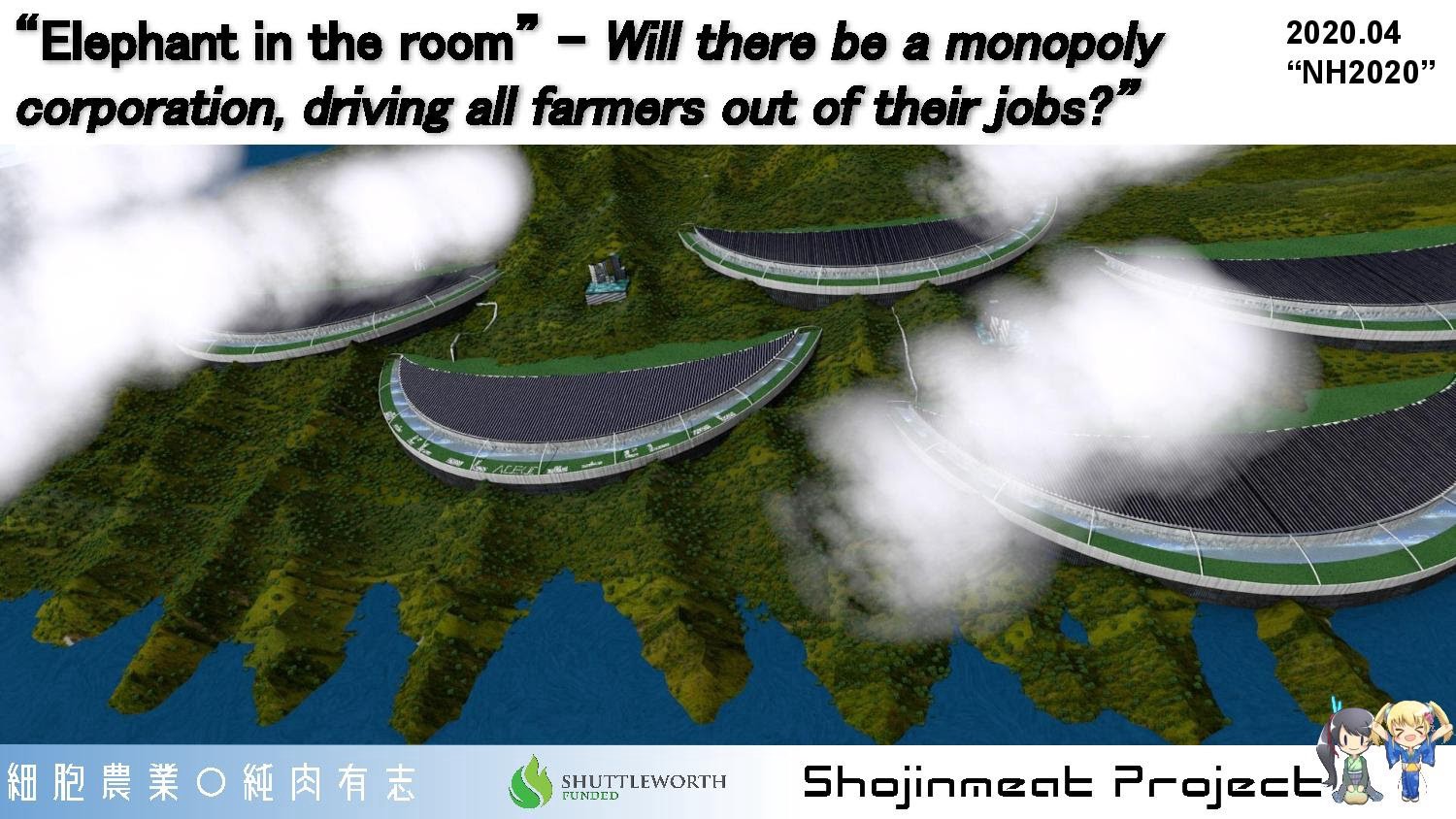
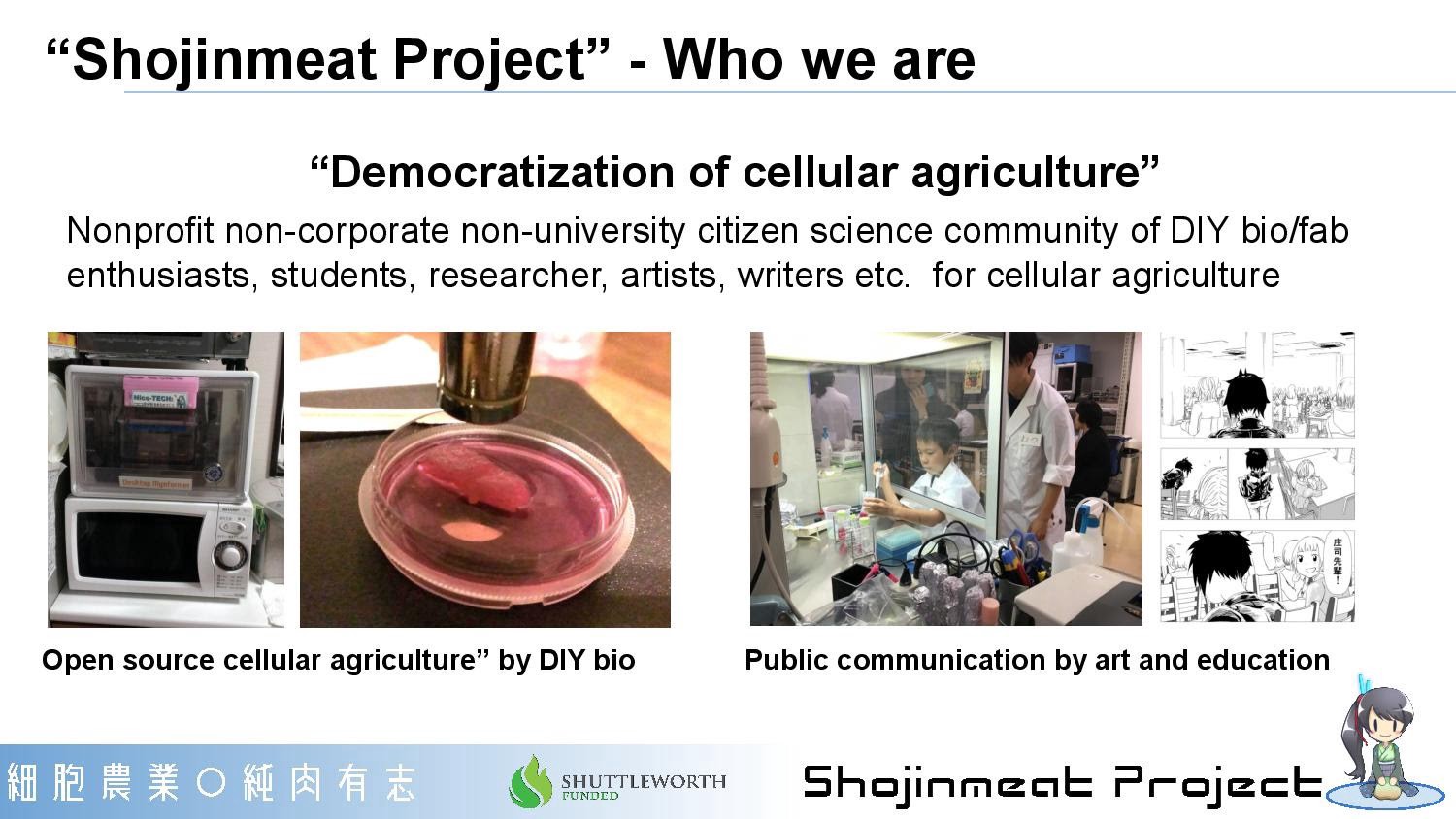
“Shojinmeat Project” is a citizen science community, or hobbyist’s’ club, of people who are generally interested in DIY-bio, cellular agriculture and cell-based meat. Our goal is to democratize cellular agriculture by bringing the news and technology to ordinary citizens.
Our technological goal is to develop hardwares and protocols for DIY cell-based meat so that anyone, like elementary school kids, can grow meat at home.
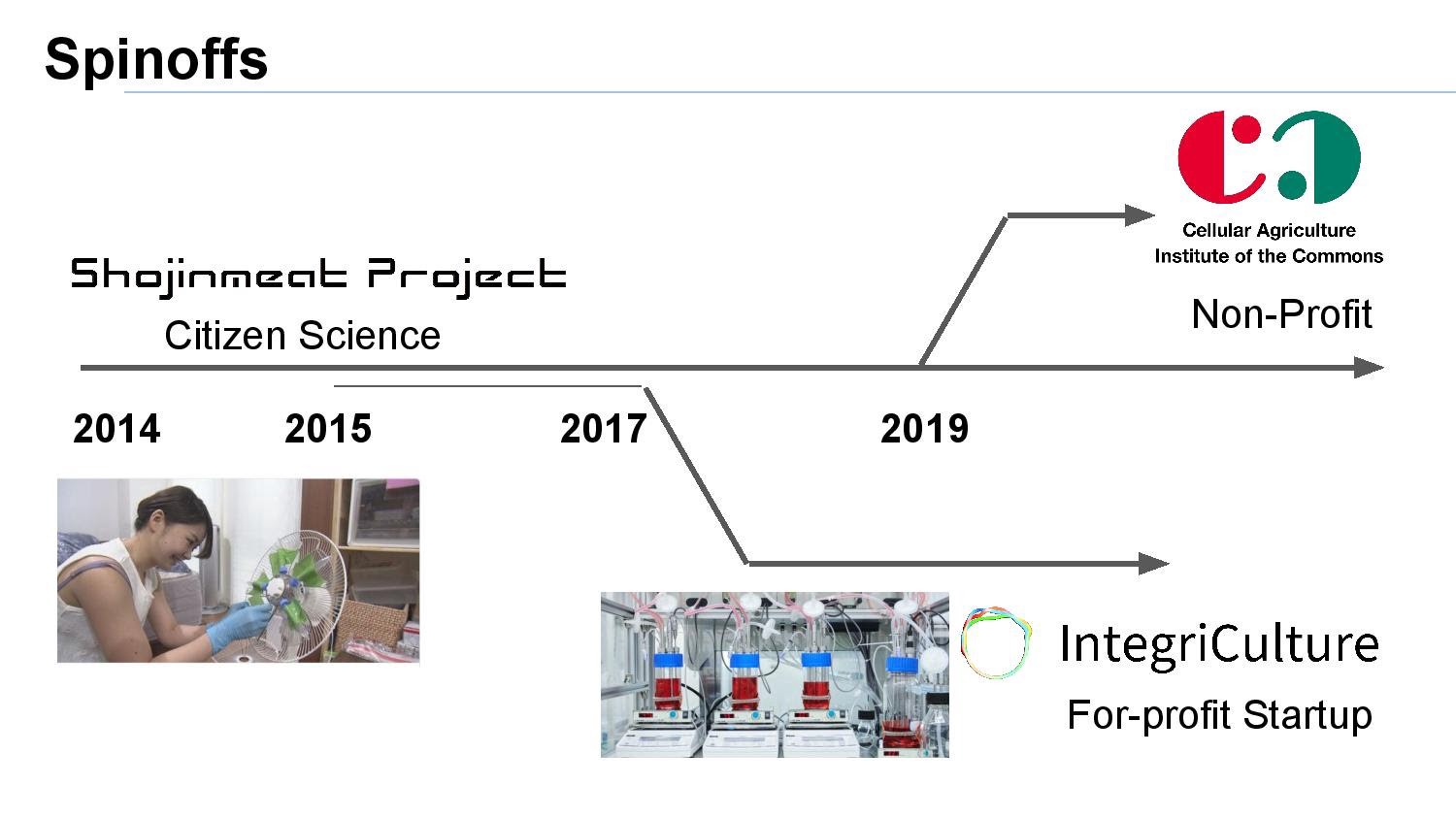
Shojinmeat Project is a hobbyist club and does not have a legal entity, but we have 2 spinoffs with legal entities. One is IntegriCulture Inc., and the other is a non-profit like New Harvest. IntegriCulture Inc. originally existed only on legal documents, to purchase lab reagents and equipments, but it formally became a spinoff in 2017–2018 with seed round fund raise.
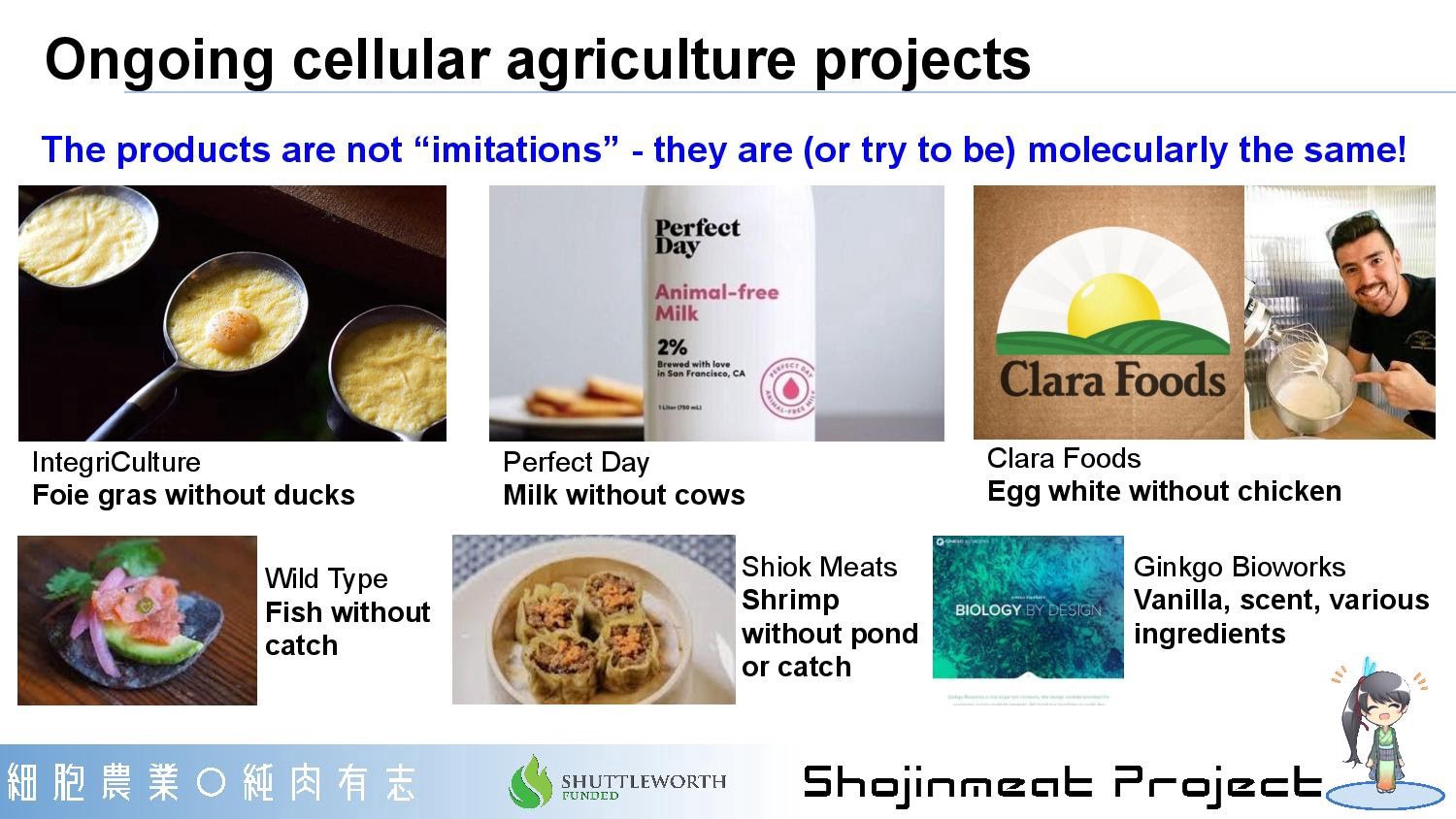
So, back to our main topic of conversation — cellular agriculture. The recent progresses have been amazing, with whole range of animal-derived products prototyped by cell culture technology. Many are soon entering or have entered market, and acellular products like milk and egg seem slightly ahead of cellular products like meat and fish.

The cellular agriculture industry is entering the scaling phase now. The whole process is moving out of the labs to factories. The process stops using familiar equipments like pipettes and dishes, but adopting industrial equipments like large bioreactors and pipelines.

Cell-based meat and cellular agriculture coming to reality sounds like a dream come true. But there is an issue. Who will be in control?

Will there be a monopoly corporation?
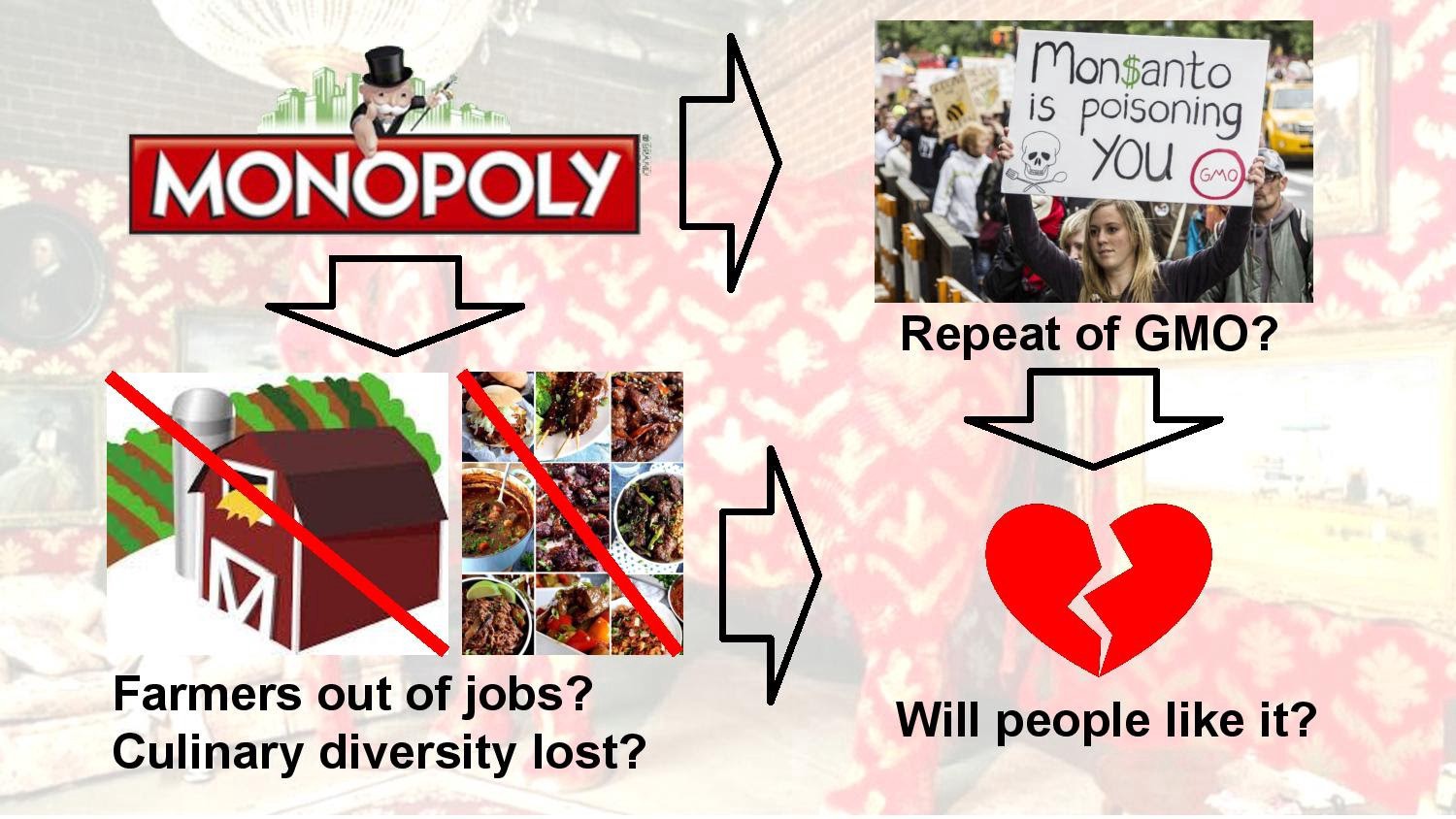
What will happen to the livelihoods of hundreds of millions farmers, with majority of them in poorer countries? Agriculture is so part of countryside scenery, culture, culinary diversity and are we losing them all?
This is also an issue for public acceptance of cellular agriculture. The unfortunate history of genetically modified food may repeat, if corporations in monopoly positions take aggressive stances on intellectual properties, or something goes wrong in their PR. These all come back to the question, “will people like it”, or in other words, “is that the future we want?”
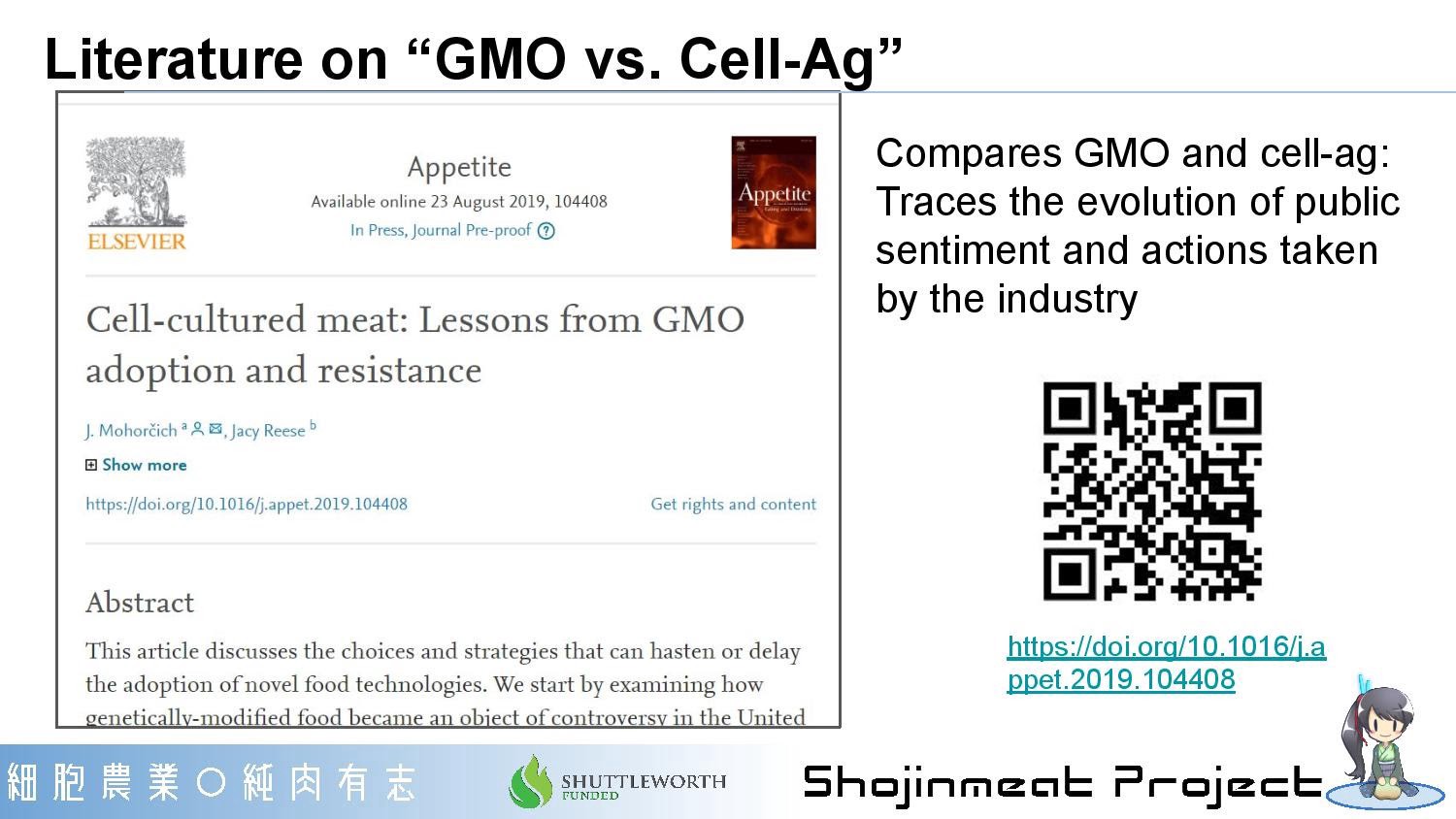
The similarity between GMO and cellular agriculture in public acceptance space is discussed in literature by Jacy Reese. This literature navigates us not to repeat the mistakes GMO has made, but we will probably need more detailed picture of what is to come for cellular agriculture to take real actions.

Here is a very rough schematic of cellular agriculture entering mainstream. Cost-benefit on the Y axis is the customer satisfaction per unit money. It is taste, convenience, instagrammability, ethical feel-good factors and such divided by the price. And as the technology improves, the cost-benefit of cell-based meat increases, to a point where it exceeds that of conventional meat. This is the “price parity”, where cell-based meat is officially “superior” and people actively choose cell-based over conventional.
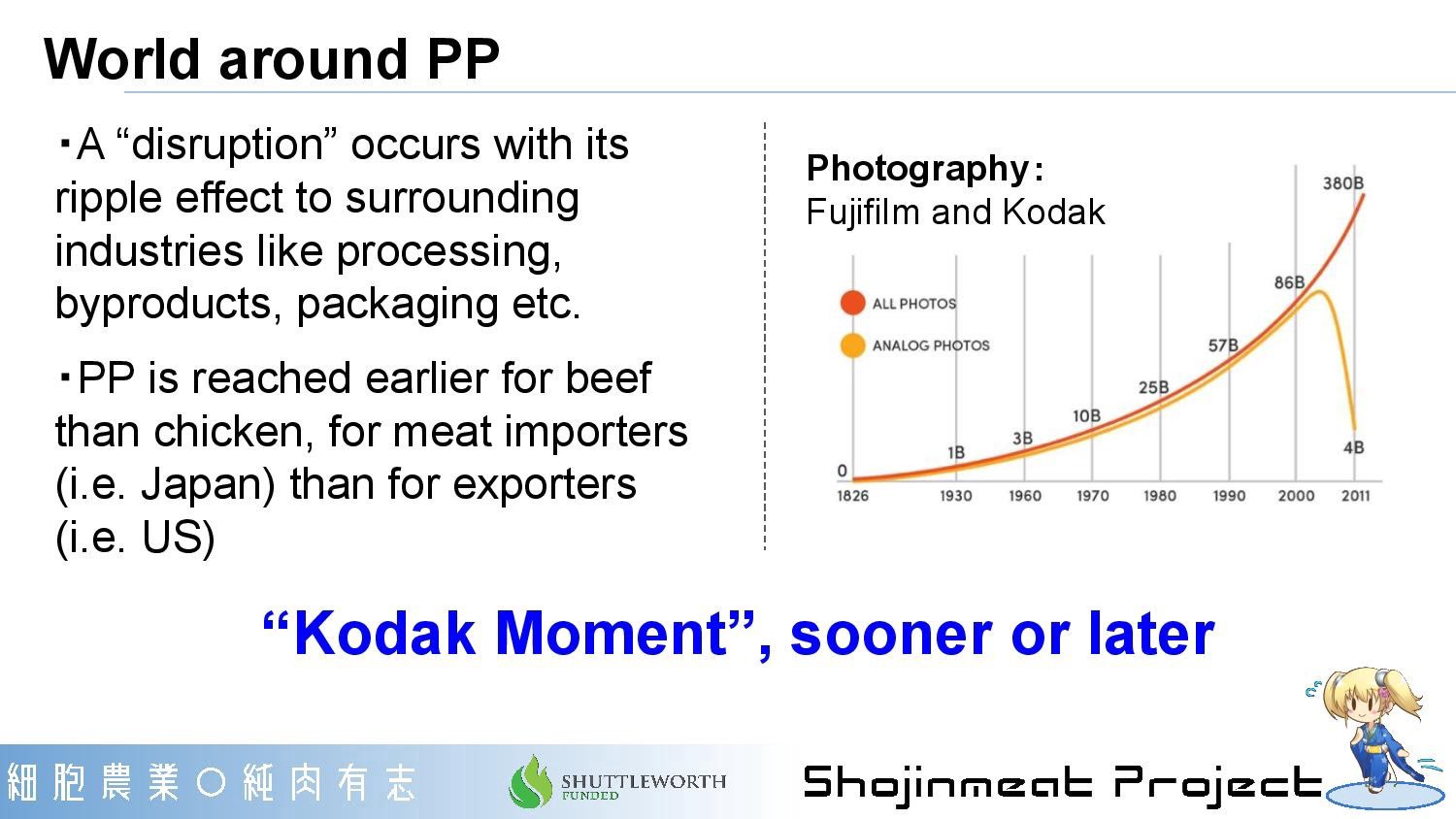
When it happens, it is often said that a phenomenon called “disruption” happen. The ripple effect would probably affect all surrounding industries. This would happen earlier for a product category with higher unit price. It would happen earlier in importing countries than in exporting countries.
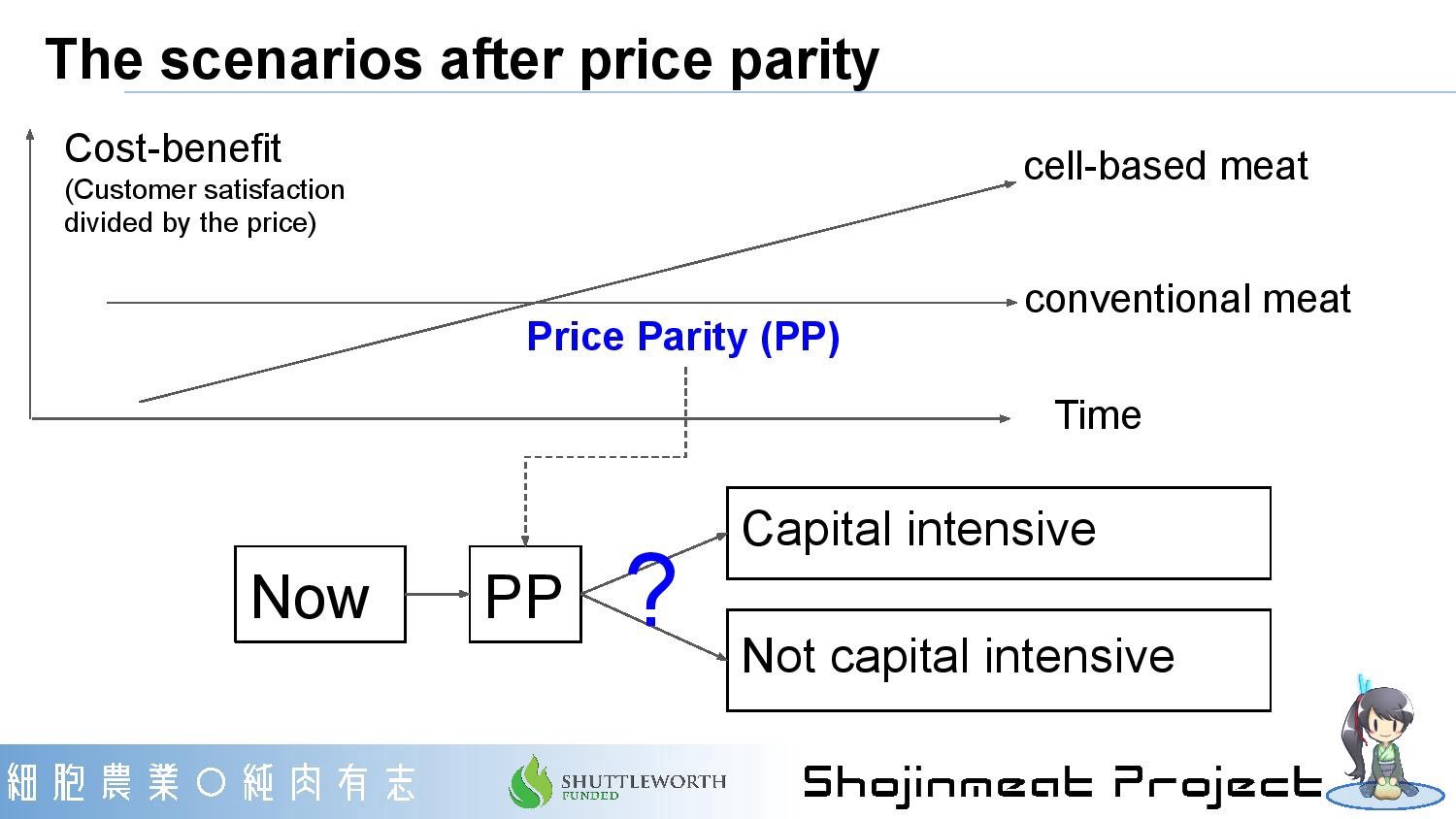
Then we have 2 possible scenarios afterwards, and one of the crossroads is the amount of upfront capital investment required to build a facility that is large enough to produce meat at a market-competitive price. This is also called “minimum efficient scale” in economics.
Capital intensive scenario is high-MES, and not capital intensive scenario is low-MES, and we will see a very different landscape after attainment of price parity. But of course, there are scenarios that lie somewhere in between.
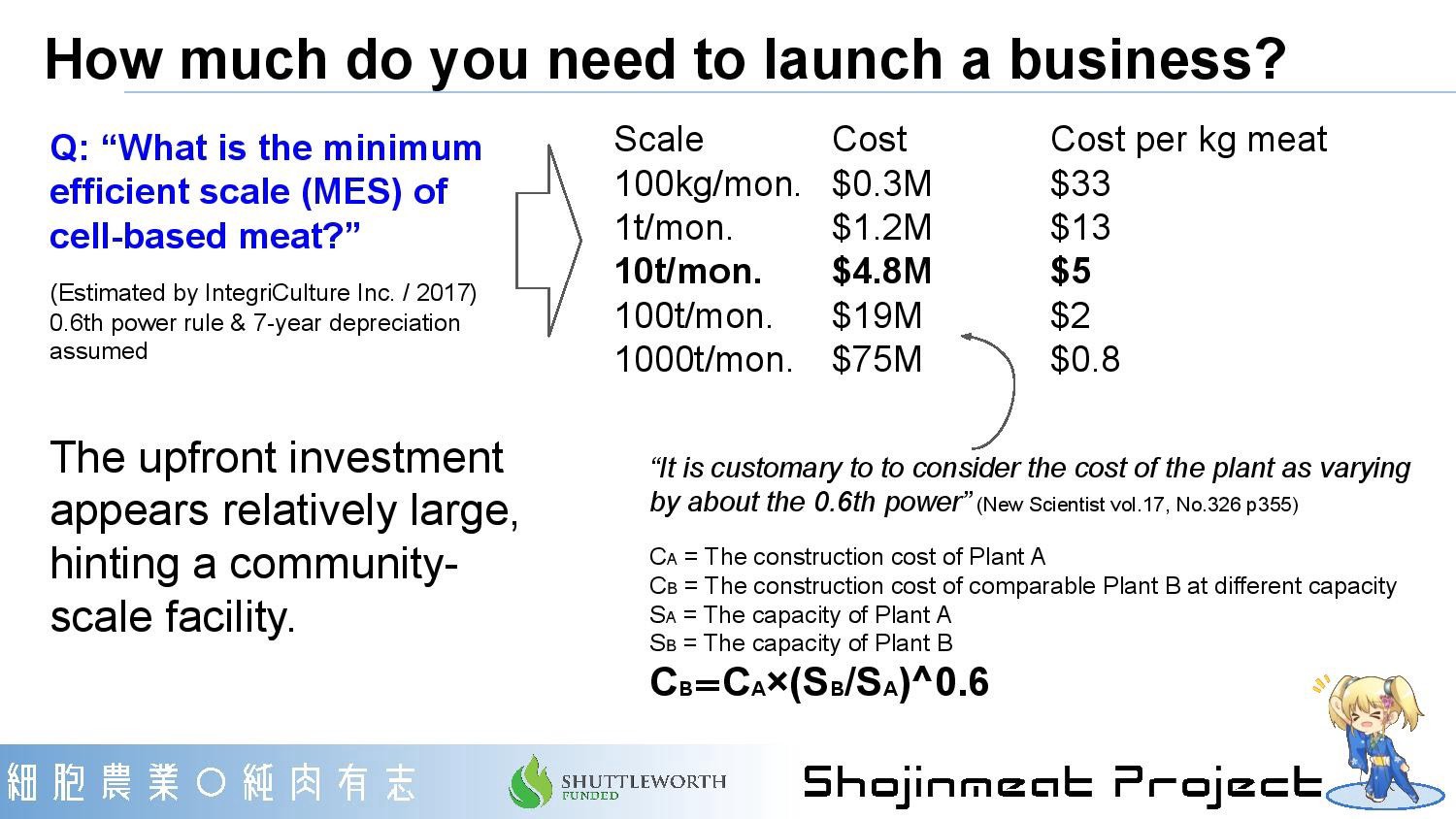
Bioreactors can be a very large upfront investment. A cost estimate by IntegriCulture company assuming existing technologies suggests that upfront investment is rather too large for individual farmers. To build a facility capable of producing meat at a market-competitive $5/kg, it takes $4.8M upfront investment. So, community scale bioreactors would be more likely.
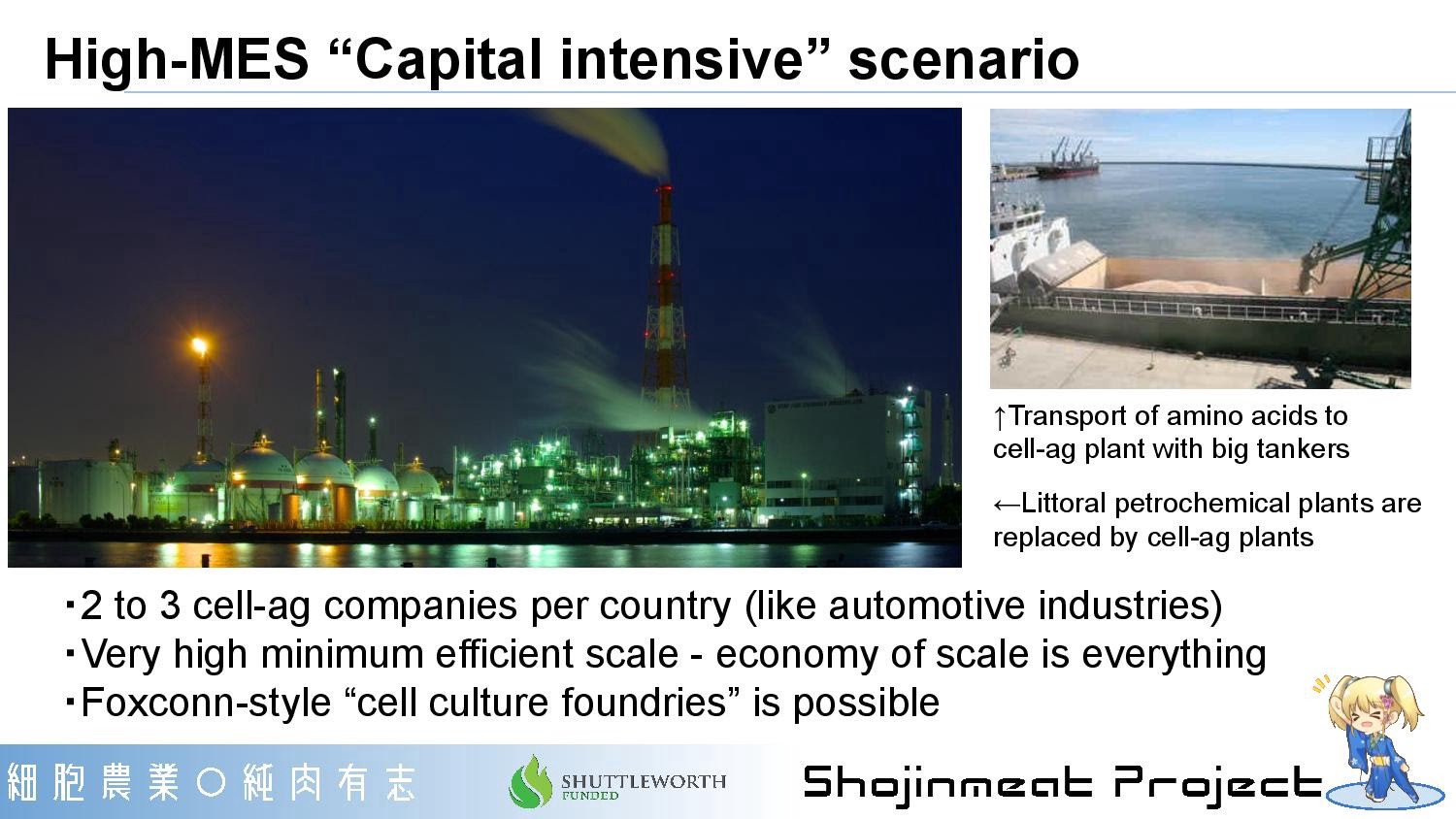
Let’s say, the estimate by IntegriCulture is wrong, and we actually need even bigger facility. In that case, we would see high-MES scenario. In this world, we are seeing mega-scale plants by large corporations. Cellular agriculture plants replaces littoral petrochemical complexes. The raw materials — sugar and amino acids, will be carried by tankers.
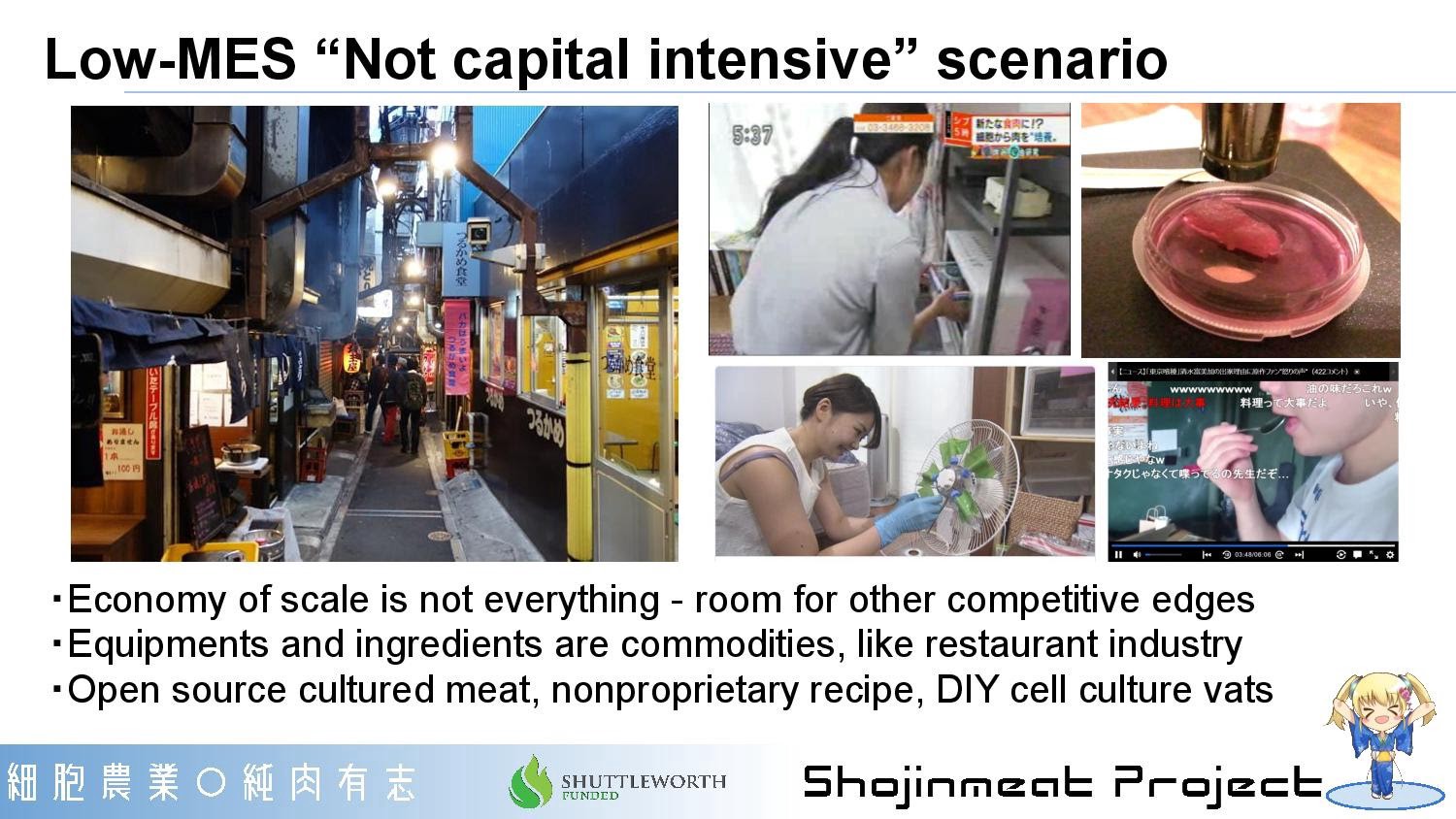
If IntegriCulture’s estimate is wrong in the other direction, it is the low-MES scenario. In this world, the economy of scale becomes less dominant, and there would be more players in the cell-ag sector. Many people may gain access to the technologies of cellular agriculture, by some means like open source cell culture recipe or an accessible cell culture foundry.
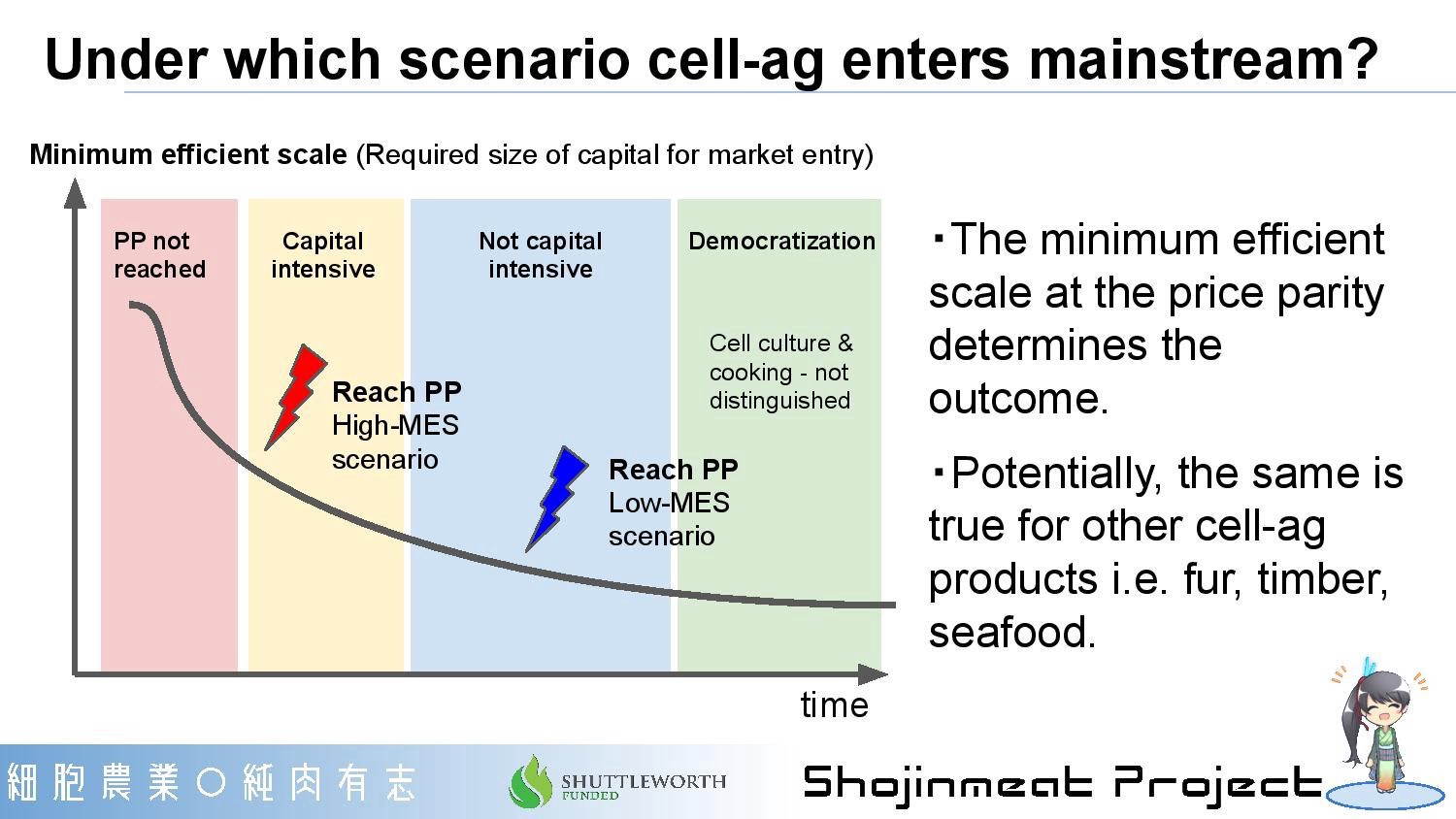
So to summarize this bit, when the price parity is actually reached, the size of minimum efficient scale determines which scenes of future we would see — gigantic cellular agriculture complexes by large companies, or distributed meat breweries and home-scale bioreactors in street restaurants and bars.
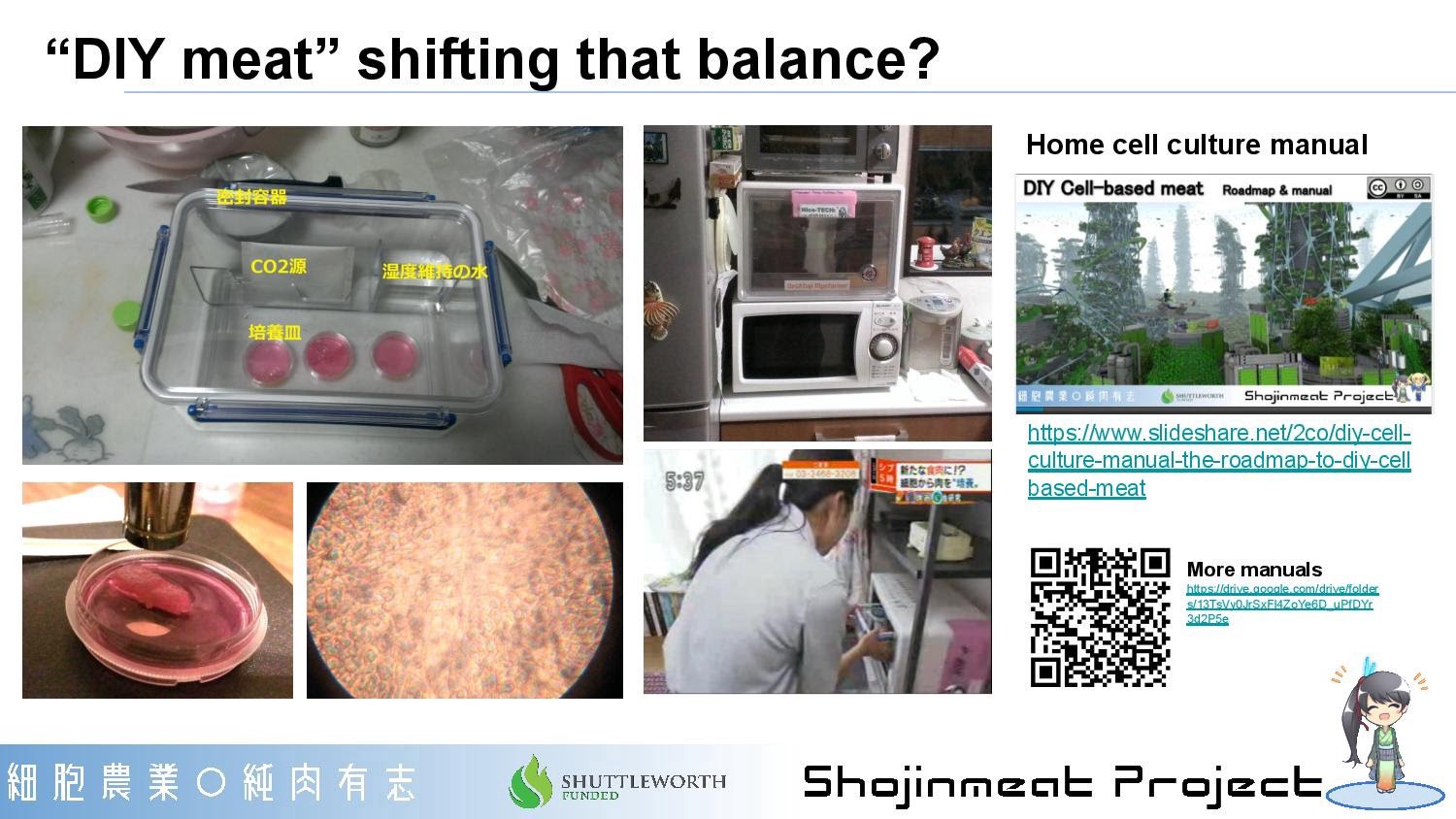
Meanwhile in DIY bio space, many of the efforts are aligned toward making things cheaper. Shojinmeat Project is no exception, by developing DIY cell culture hardwares and protocols.
This experiment was done in my kitchen, not a proper lab. There’s another experiment done by a high school student. The manual is available online and people are copying and improving on it.
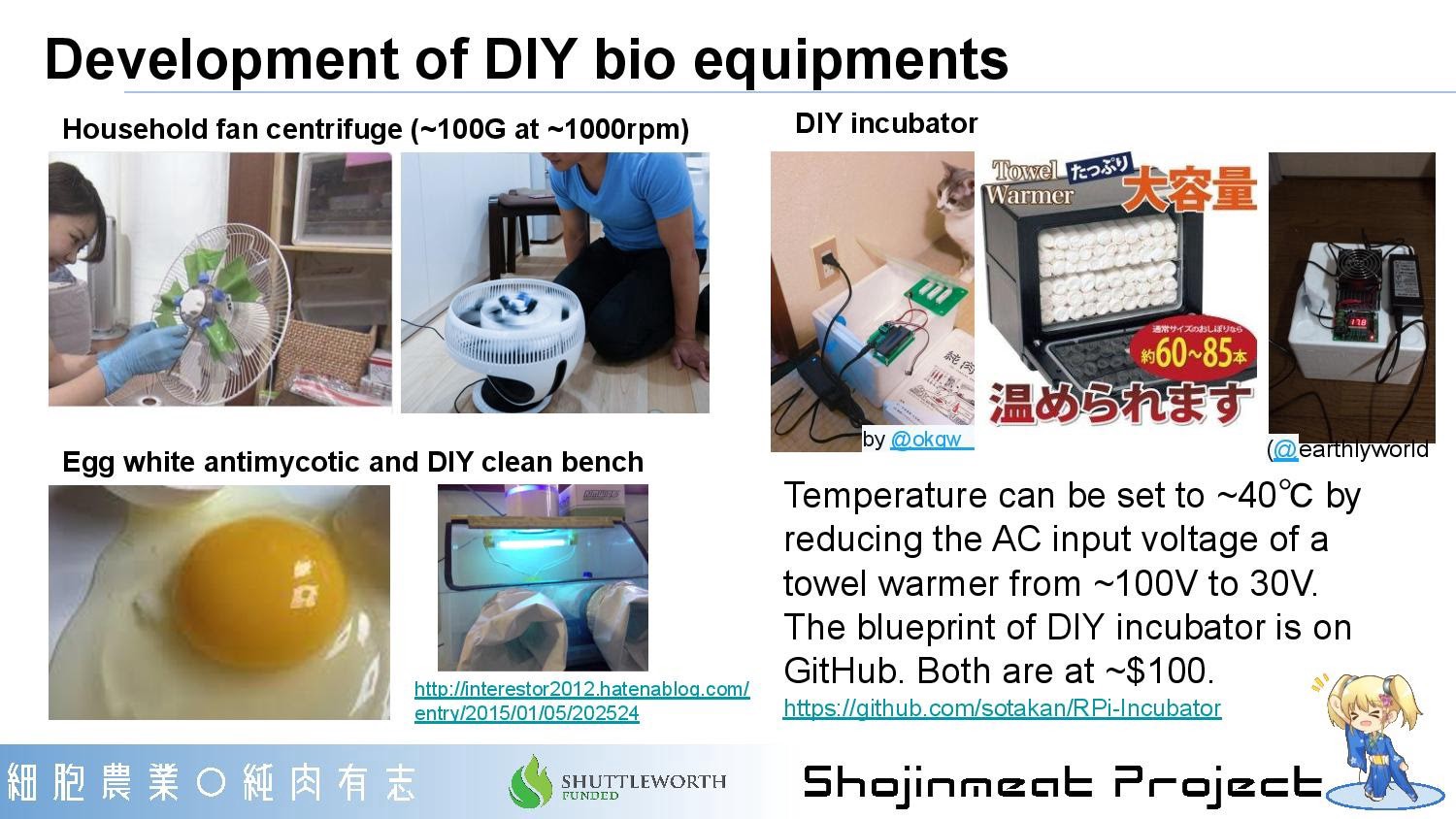
Equipments — we just use anything available. A fan as the centrifuge, DIY incubator, repurposing of a towel warmer, DIY clean bench or egg white as antimycotic agent to beat contamination. These developments are shared to the whole community and wider public. This ensures that results are reproducible, and more improvement can be built on top.
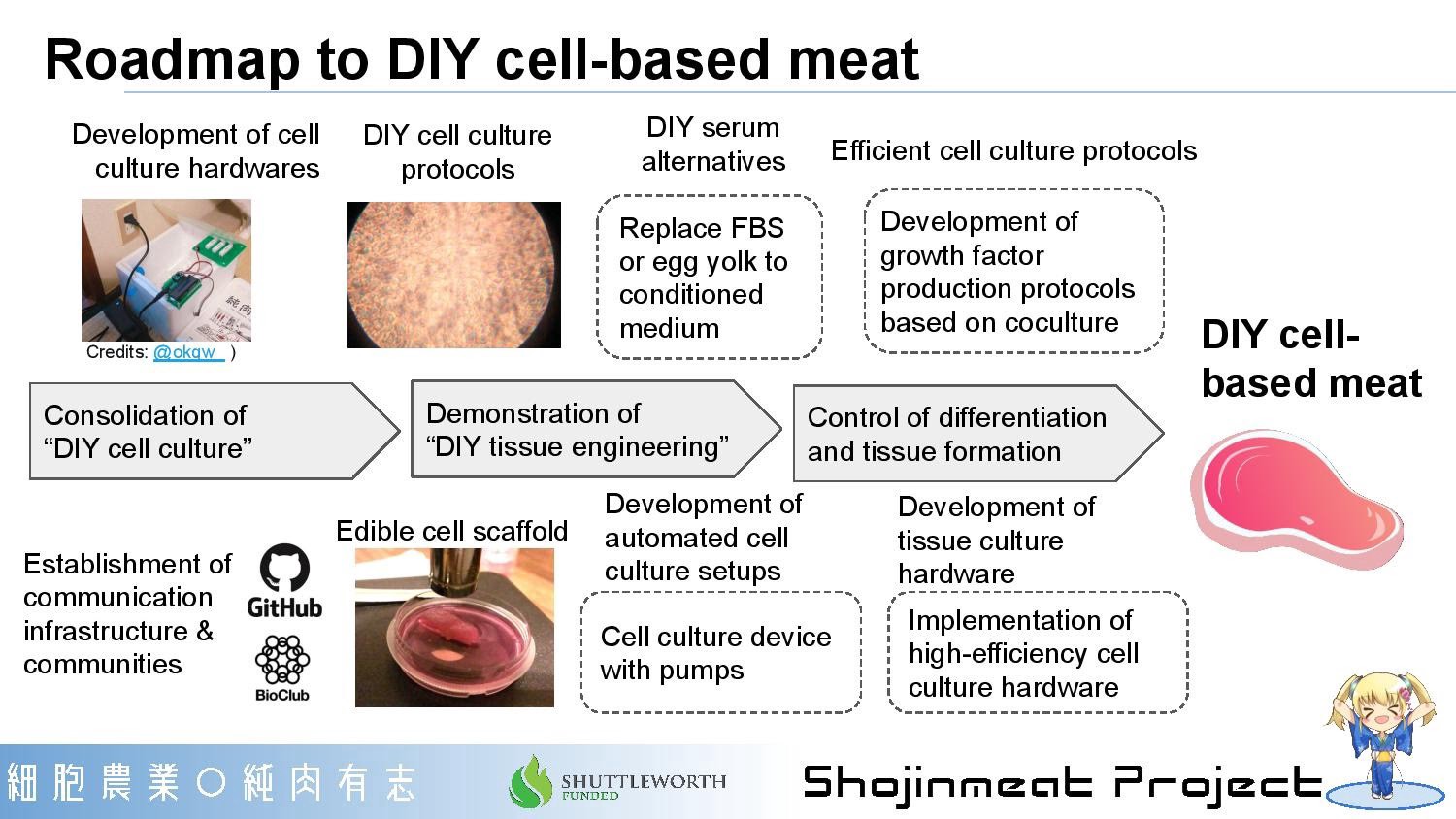
Here is a roadmap toward real “DIY cultured meat”. We are at DIY cell culture now, with proof of concept completed for incubators, communication channels, cell culture protocol and edible scaffold. The 4 topics toward the right in dotted lines are what remains to be done. You could have a look here for more details or could even edit to add improvements.
https://www.slideshare.net/2co/diy-cell-culture-manual-the-roadmap-to-diy-cellbased-meat
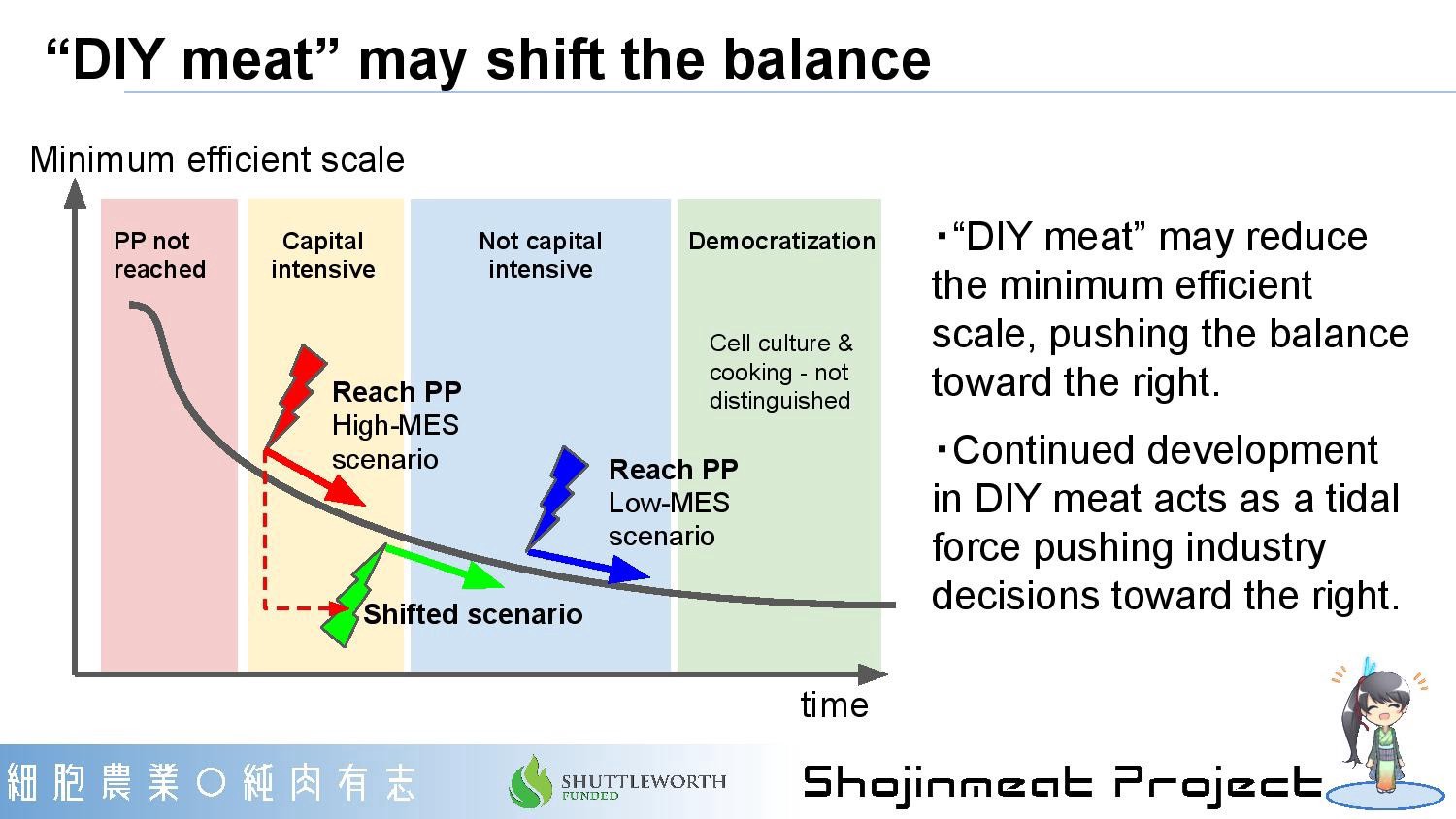
All these efforts can affect the future scenarios. First, they can bring down the MES to push the equilibrium from high-MES scenario to low-MES scenario. On top of that, the fact that “an open source cultured meat is being developed” alone, can influence industry and business decisions toward the right.
And like in any other industries, technological progress makes everything cheaper eventually, toward “democratization” on the right, where anyone can cheaply make meat.
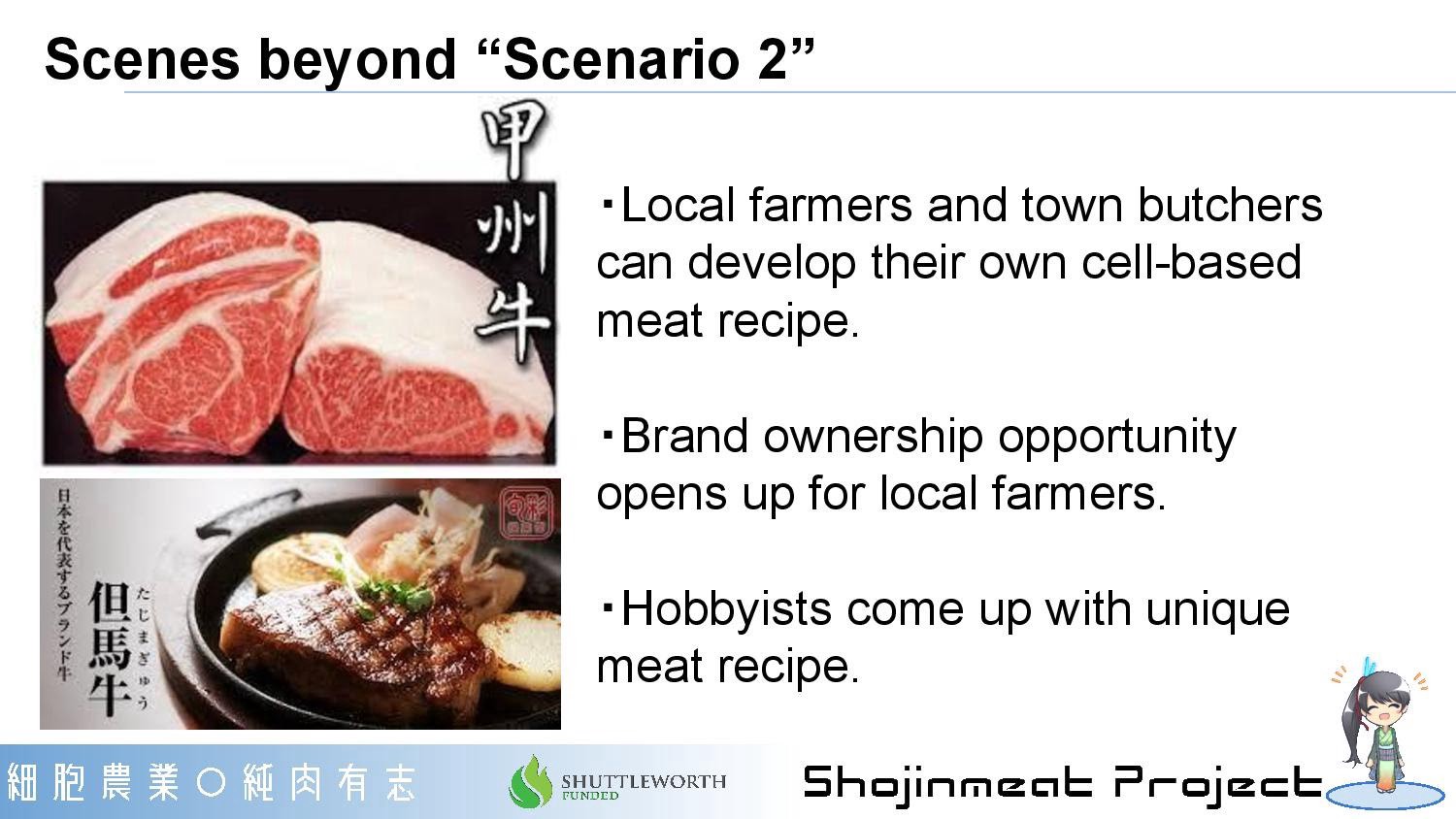
So, if cellular agriculture is actually democratized, what would happen? Especially farmers? Well, they can develop their own cell-based meat. That opens brand ownership opportunities to farmers. Creative meat enthusiasts could also join.
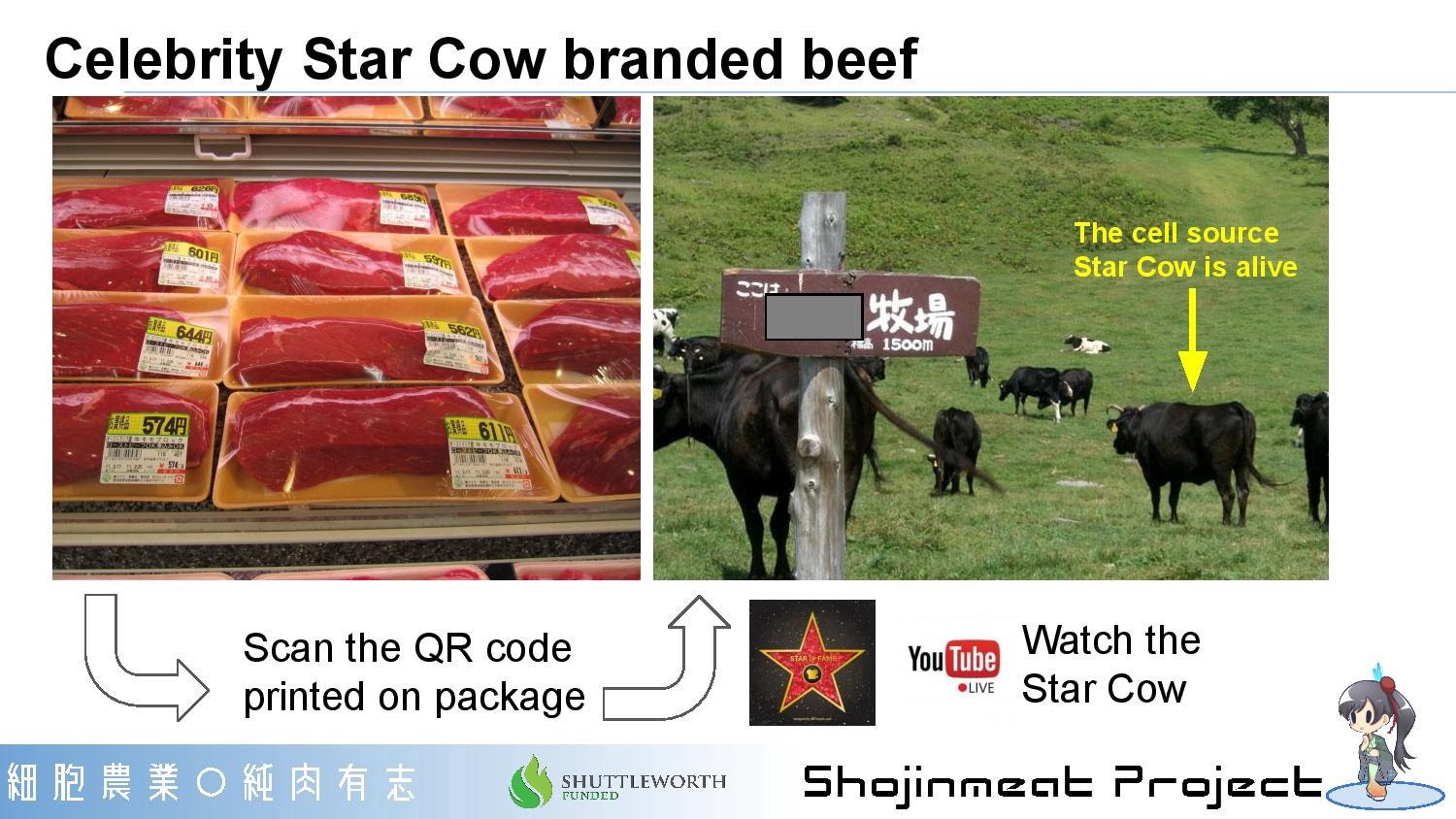
A farmer may decide to turn a cow into a pop star. The meat from the Star Cow could be sold at a premium. If you go to a supermarket, the meat package has a QR code printed on it, and if you read the code with your phone, it connects to a YouTube Live of how the Star Cow is doing today. There might be a talent agency for help. They already do cats, dogs and other exotic animals, so why not expand to farm animals?
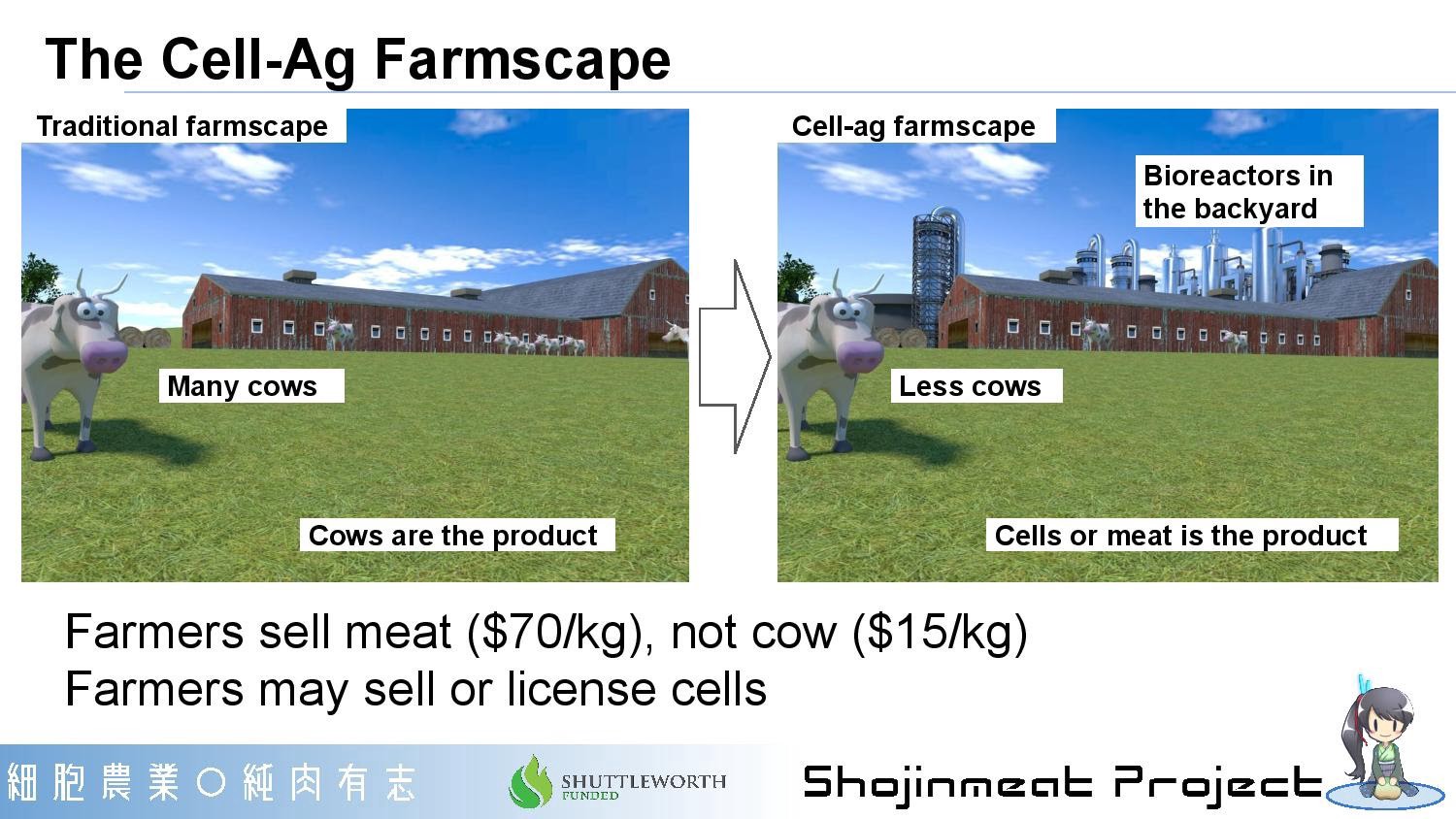
If show-biz is not a farmer’s thing, one can install cellular agriculture systems in the backyard. There would be fewer cows, and selling meat at $70/kg than cow at $15/kg.
( Some early financial estimates of cell-ag farmers : https://www.slideshare.net/2co/the-cellular-agriculture-farmscape )
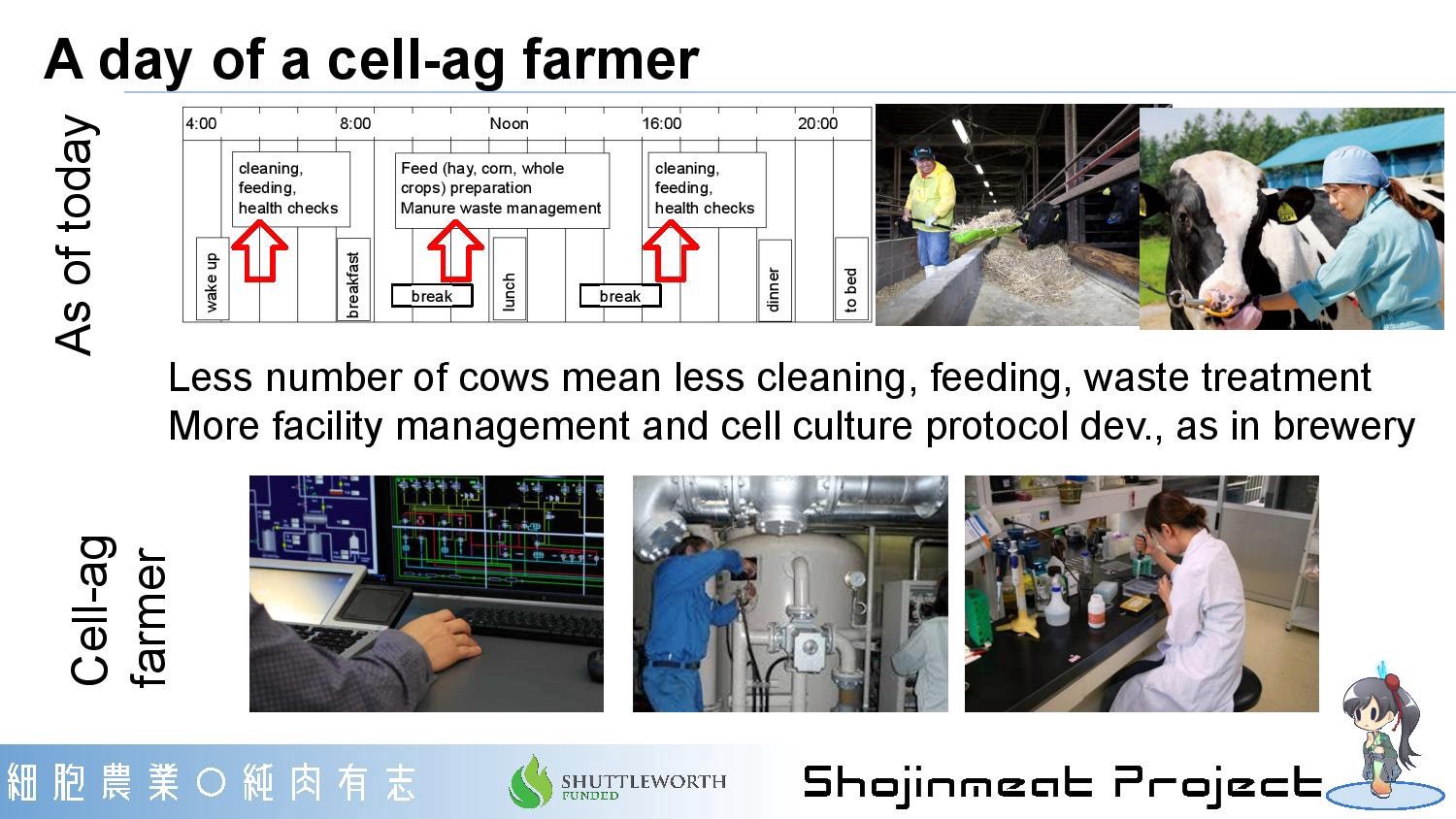
The daily routines will change. Traditionally, animal agriculture has never been a easy job, involving heavy physical labor throughout a day. A cellular agriculture farmer in contrast, will look after fewer cows and “scoop less shit.” Instead, the farmer would look after bioreactors and possibly, develop recipe for new meat and certainly much less heavy physical labor.
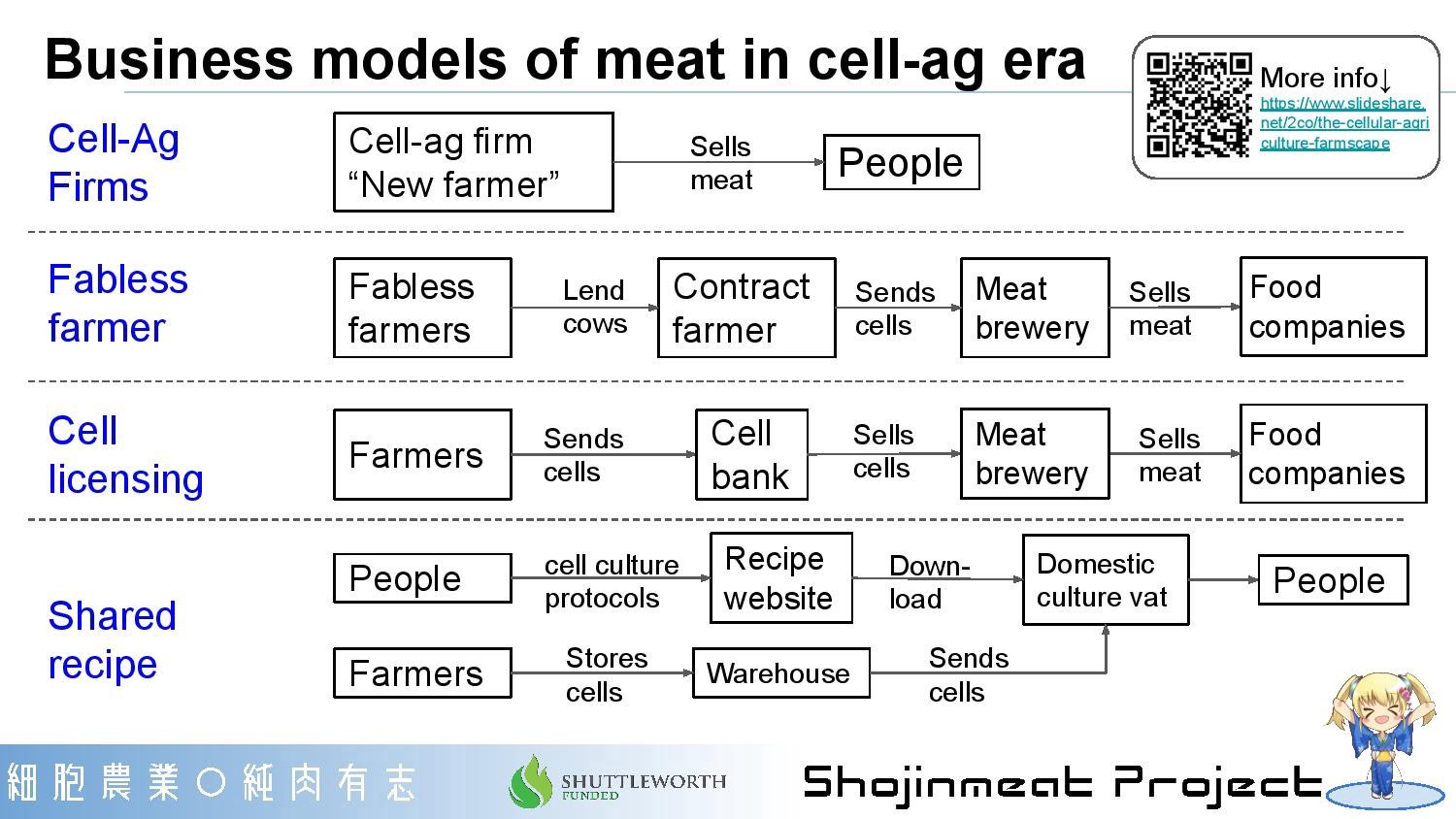
Perhaps, a farmer doesn’t even need a bioreactor in the backyard, if cells can be licensed. Perhaps, you don’t even need to own a farm, because you can lend your cow to a farmer who looks after your cow. In more extreme cases, you could culture meat and develop new meat recipe at home, and share over the web.
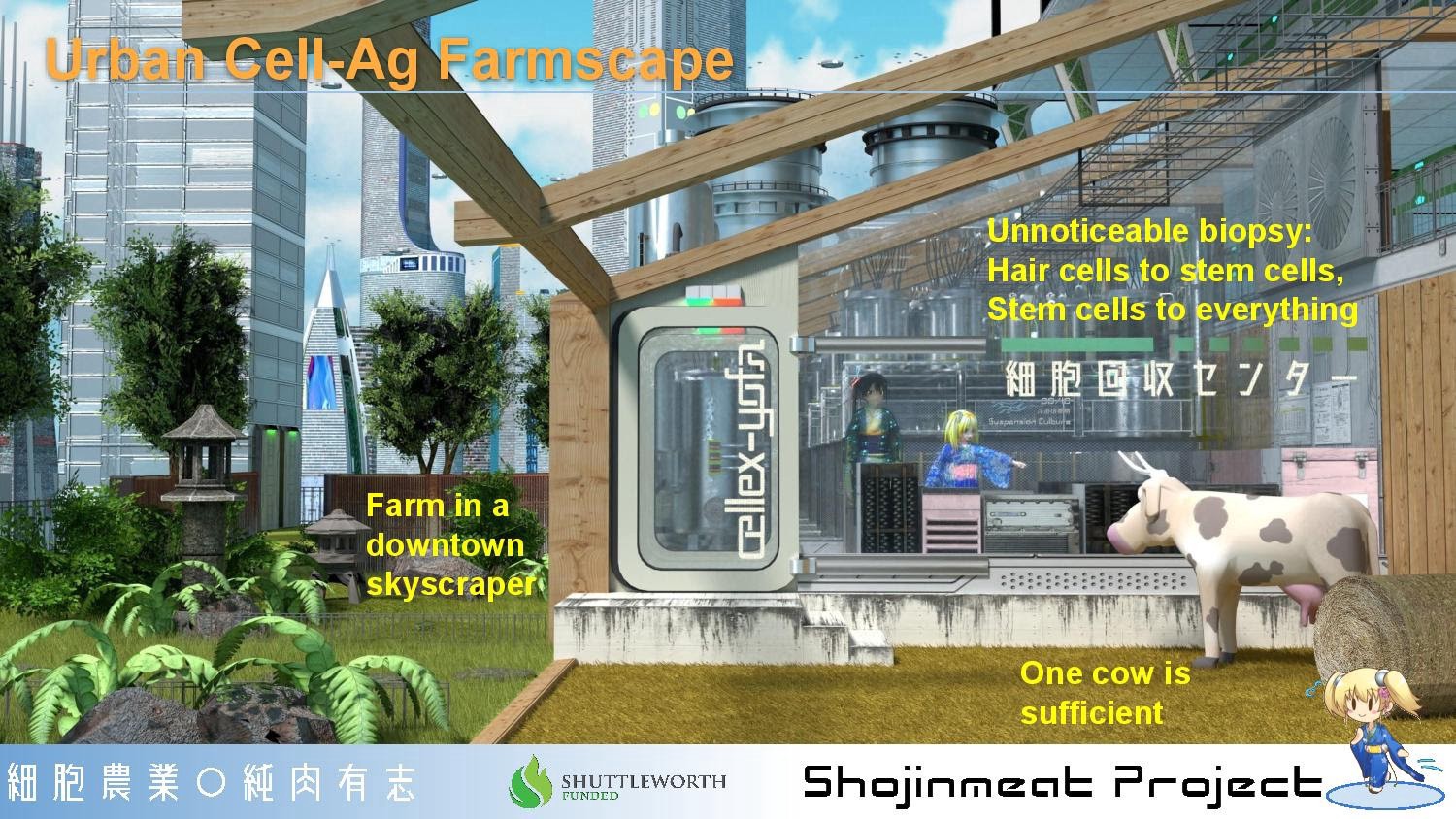
This picture shows one of the possible infrastructures that supports such businesses. This is a cell extraction facility in an heavily urban setting. Urban dwellers can own and keep a pet farm animal, and extract cells occasionally for meat production. The consumers who also live in this city could always visit and meet the Star Cow.
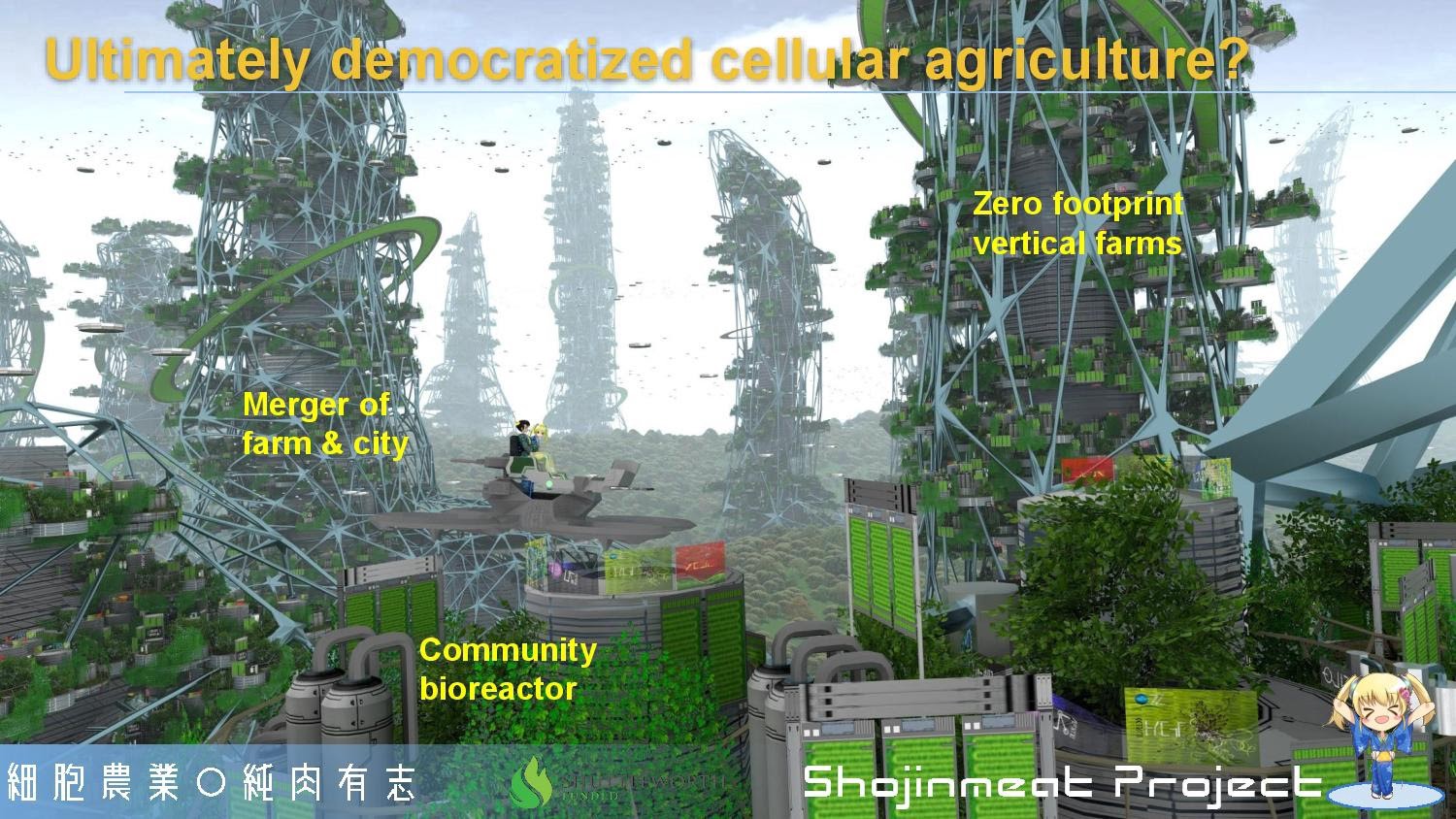
When pushed to extreme, we may see this solarpunk scenery, with community scale bioreactors, merger of farm and city, and zero environmental footprint vertical farms. I would like to see a sci fi anime in world settings like that!
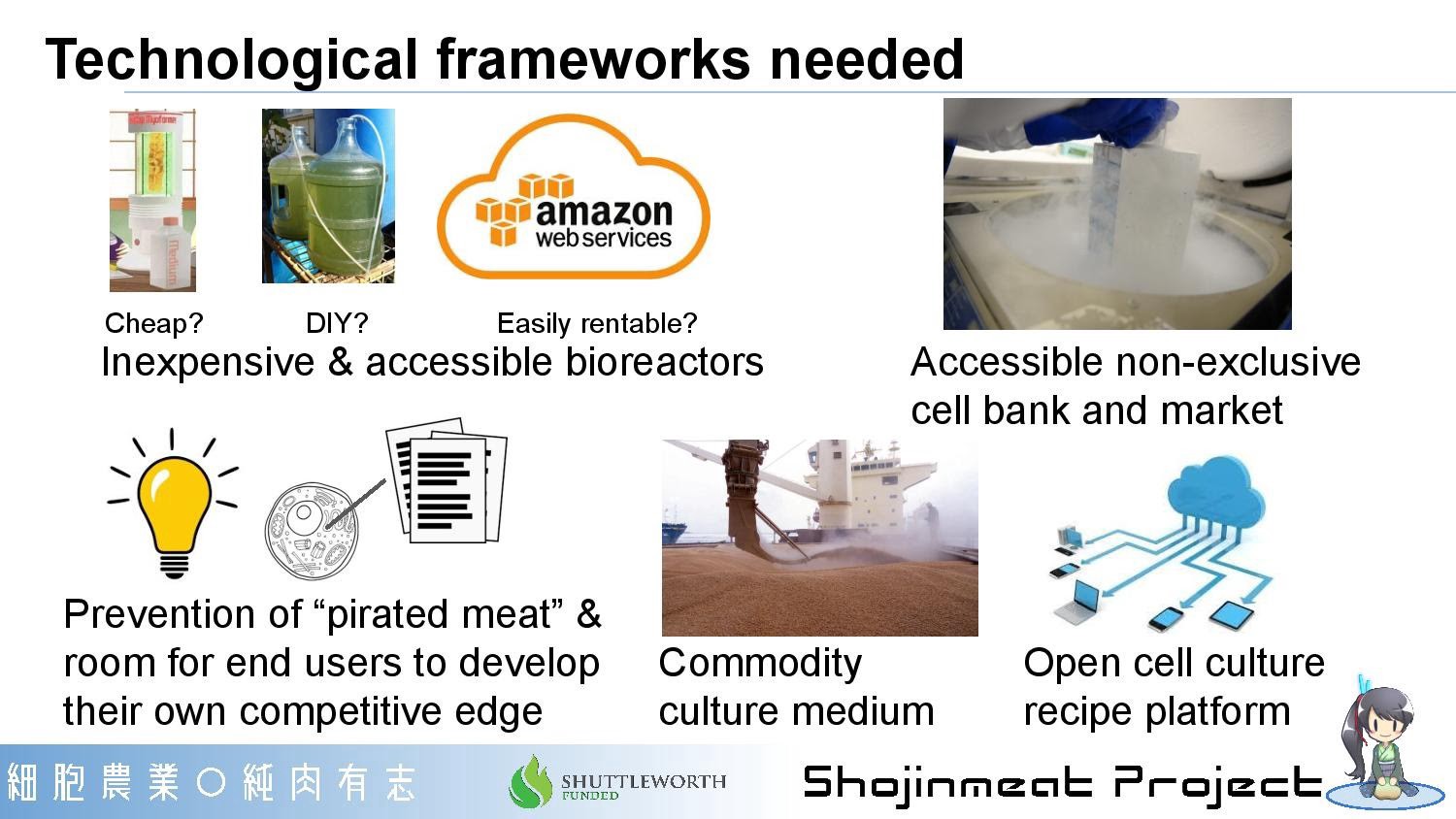
That stuff was a bit wild, but if we are to get there, what technological frameworks do we need? We would need accessible bioreactors or cell culture services, accessible source of cells, some form of IP protection to avoid fake or pirated meat, cheap culture medium, and some means to share meat culture recipe.
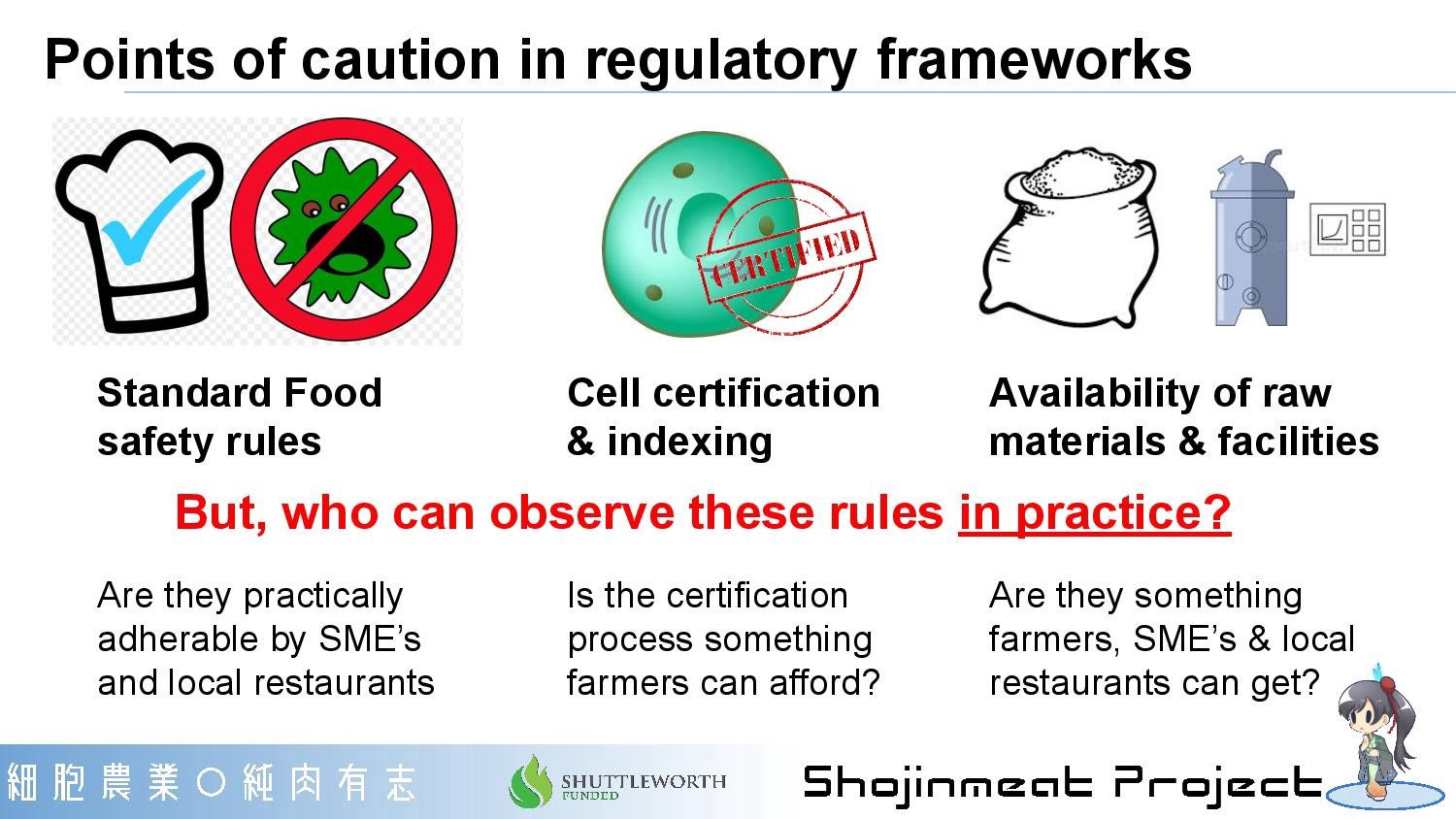
It would also need some regulatory frameworks, like standard food safety rules, cell licensing rules and availability of materials and facilities. But we have to be careful about the practicality of these rules, as the rules can easily be designed to exclude farmers and SME’s.

Such rules are made through rulemaking processes, and what interests to represent would become the key. There is a rulemaking process going on in Japan, lead by Cellular Agriculture Institute of the Commons and Tama University Rule-making Strategies. Participants include food companies, cell-ag startups, policy makers and others. If you imagine if farmers and general public are absent from here, the rules would heavily represent food companies.
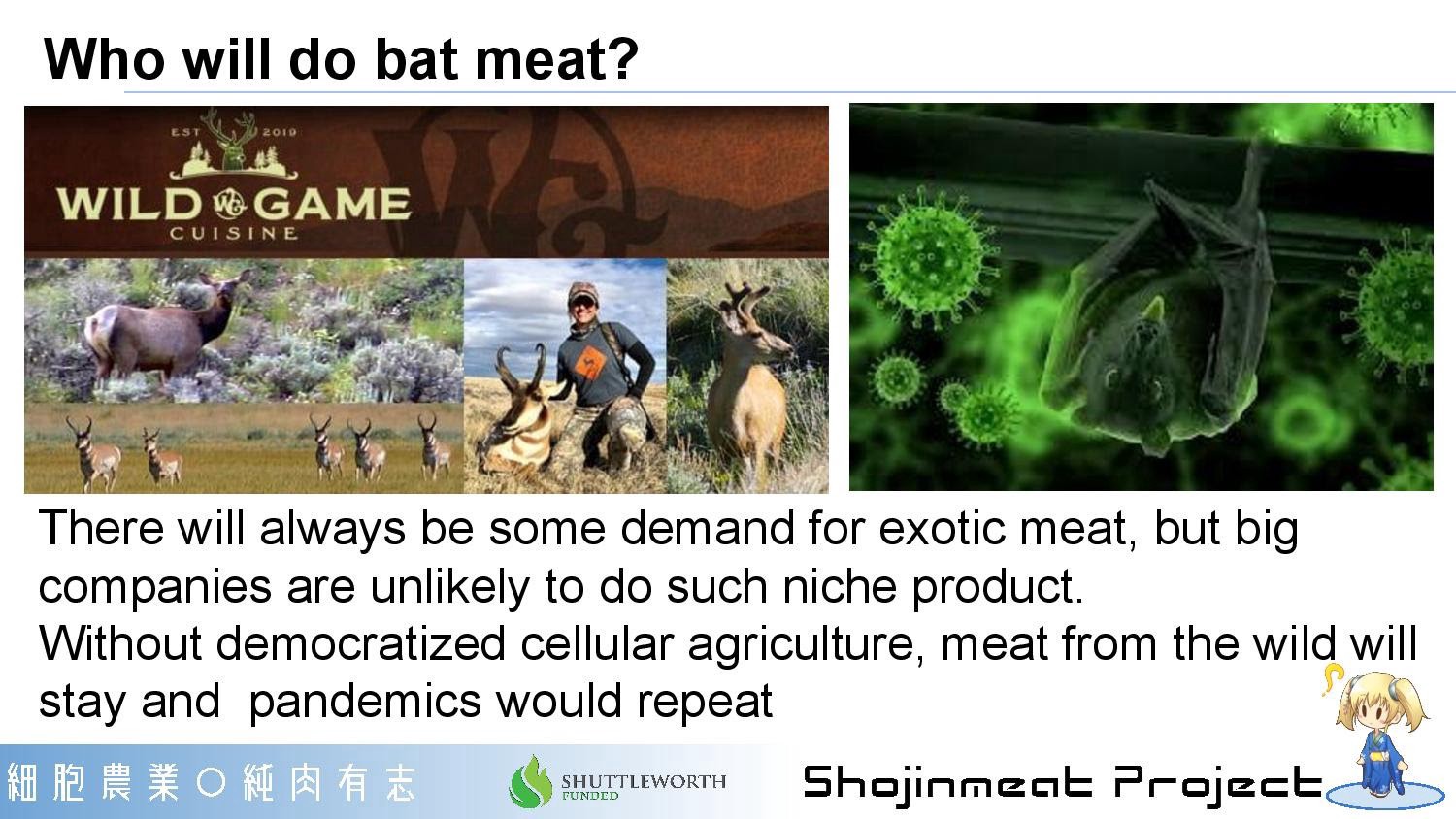
On the last note, I don’t know if Covid-19 actually came from bats, but there will always be people wanting exotic meat like bat. But if only large companies serve cell-based meat, they wouldn’t do such niche product like bat meat. So, people go out hunting bats, repeating the pandemic. So, there should be an option for people to make their own cell-based meat.
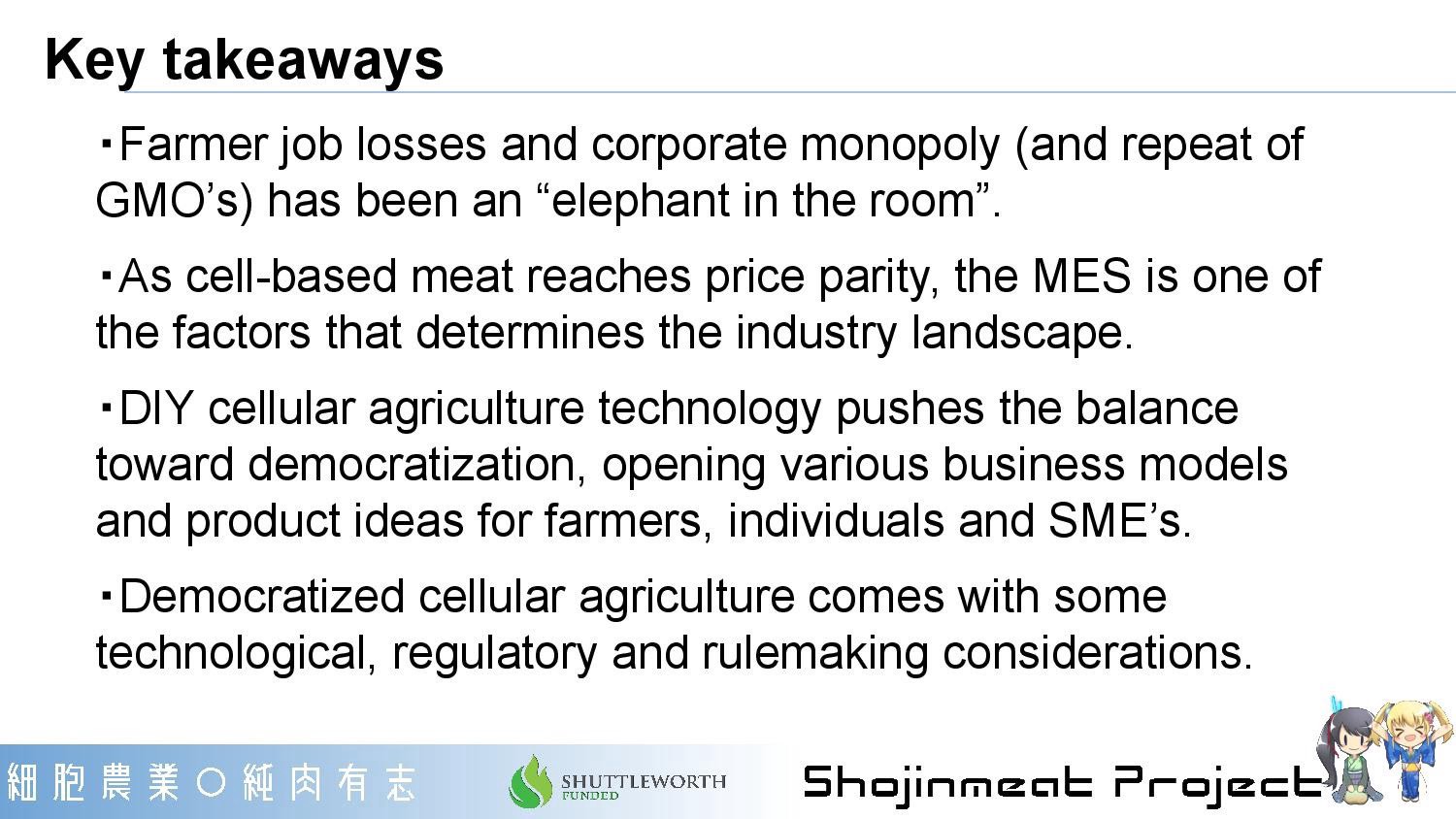
So that was it from me. Here are the key takeaways from this presentation. Thank you very much for your patience.
Originally published by Shojinmeat Project at https://medium.com on May 11, 2020.

